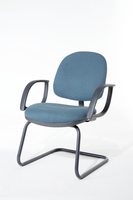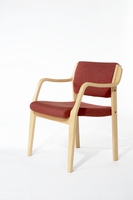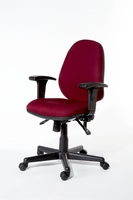Advice
Seating - operator, task, management, meeting and reception
Monday, October 22, 2012
Possibly the most important part of the office as this is what you are connected to all day. There are a couple of main types of seating, meeting and operator.
MEETING CHAIRS:
 There is not a lot to say here. There are two main types of legs, cantilever which give some spring so can be more comfortable if you are in them for a long time and 4-leg which don't have that give. It doesn't mean that they are uncomfortable but obviously don't have the bounce.
There is not a lot to say here. There are two main types of legs, cantilever which give some spring so can be more comfortable if you are in them for a long time and 4-leg which don't have that give. It doesn't mean that they are uncomfortable but obviously don't have the bounce.
OPERATOR CHAIRS: There are lots of things to go through here but we will try and keep it as simple as possible. What we are talking about here is desk chairs that you will work at a desk on. They are also known as secretarial chairs, task chairs, managerial chairs and executive chairs. Really they are all pretty similar but as a rule of thumb, secretarial chairs are generally more lightweight and only really useable for a few hours a day. Operator chairs are your standard desk chairs. Task chairs are generally a bit heavier and harder wearing with more features. Then Managerial and Exec chairs are more high backed.
There are lots of things to go through here but we will try and keep it as simple as possible. What we are talking about here is desk chairs that you will work at a desk on. They are also known as secretarial chairs, task chairs, managerial chairs and executive chairs. Really they are all pretty similar but as a rule of thumb, secretarial chairs are generally more lightweight and only really useable for a few hours a day. Operator chairs are your standard desk chairs. Task chairs are generally a bit heavier and harder wearing with more features. Then Managerial and Exec chairs are more high backed.
The most important thing when sitting at a desk is to be at the right height. All of these chairs do this and the standard range is about 420-530mm. Not many go higher than this unless specified.
After this you add features. Almost all will have adjustable back angle and back height. On the cheaper chairs this is done by screw handles. More expensive ones use levers and ratchets.
Here is a rough guide to the terms and they are roughly in order of price too:
1-lever mechanism: This lever does the gas lift. The rest of the functions are done with hand screws and normally limited to the seat back angle and height which are not able to 'float'. (Sometimes more expensive chairs only have one lever but it can operate a few mechanisms.)
2- lever mechanism: The second lever will lock and unlock the backrest angle.
3-lever mechanism: The third lever will normally work the seat base angle.
Permanent Contact Back (PCB): This is the first of the 'floating' features. This means that you can release the back rest and then adjust the tension so that as you lean back the back goes with you. This is a great feature as no one sits in one position all day so that you are supported all the time. The tension is adjusted to match your weight so that when you lean back the chair goes back taking your weight but not pushing you so hard that you feel like you are sat in an ejector seat. Remember these chairs are designed for people from 7-20 stones so there is a big range of tension.
Synchronous Action: This is the next step up from the PCB as both the back and the base adjust for angle. Normally the base moves half as much as the back.
Seat Slide: This means that the base can be slide back and forward. This means that you can get the seat base to support you all the way along the underside of your leg. This is normally of most interest to taller people.
Pump up lumbar support: This is one of the most played with but least specified toys. Rather like a blood pressure machine you pump up a bladder in the back to give you more lumbar support.
Other bits and pieces:
Arms: Everyone wants arms but have a look around your office and see how many people actually use them. We are not totally convinced that they are necessary and our chairs without them are normally around £10 cheaper.
Colour: Chairs in blacks and blues are the most popular and most expensive so if you can consider another colour it is well worth it as you will save a few quid. At the end of the day its behind you so you cannot see it!!
MEETING CHAIRS:


OPERATOR CHAIRS:

The most important thing when sitting at a desk is to be at the right height. All of these chairs do this and the standard range is about 420-530mm. Not many go higher than this unless specified.
After this you add features. Almost all will have adjustable back angle and back height. On the cheaper chairs this is done by screw handles. More expensive ones use levers and ratchets.
Here is a rough guide to the terms and they are roughly in order of price too:
1-lever mechanism: This lever does the gas lift. The rest of the functions are done with hand screws and normally limited to the seat back angle and height which are not able to 'float'. (Sometimes more expensive chairs only have one lever but it can operate a few mechanisms.)
2- lever mechanism: The second lever will lock and unlock the backrest angle.
3-lever mechanism: The third lever will normally work the seat base angle.
Permanent Contact Back (PCB): This is the first of the 'floating' features. This means that you can release the back rest and then adjust the tension so that as you lean back the back goes with you. This is a great feature as no one sits in one position all day so that you are supported all the time. The tension is adjusted to match your weight so that when you lean back the chair goes back taking your weight but not pushing you so hard that you feel like you are sat in an ejector seat. Remember these chairs are designed for people from 7-20 stones so there is a big range of tension.
Synchronous Action: This is the next step up from the PCB as both the back and the base adjust for angle. Normally the base moves half as much as the back.
Seat Slide: This means that the base can be slide back and forward. This means that you can get the seat base to support you all the way along the underside of your leg. This is normally of most interest to taller people.
Pump up lumbar support: This is one of the most played with but least specified toys. Rather like a blood pressure machine you pump up a bladder in the back to give you more lumbar support.
Other bits and pieces:
Arms: Everyone wants arms but have a look around your office and see how many people actually use them. We are not totally convinced that they are necessary and our chairs without them are normally around £10 cheaper.
Colour: Chairs in blacks and blues are the most popular and most expensive so if you can consider another colour it is well worth it as you will save a few quid. At the end of the day its behind you so you cannot see it!!
One final piece of advice. ITS ROUGH BUT THE HEAVIER THE CHAIR, THE BETTER IT IS!!